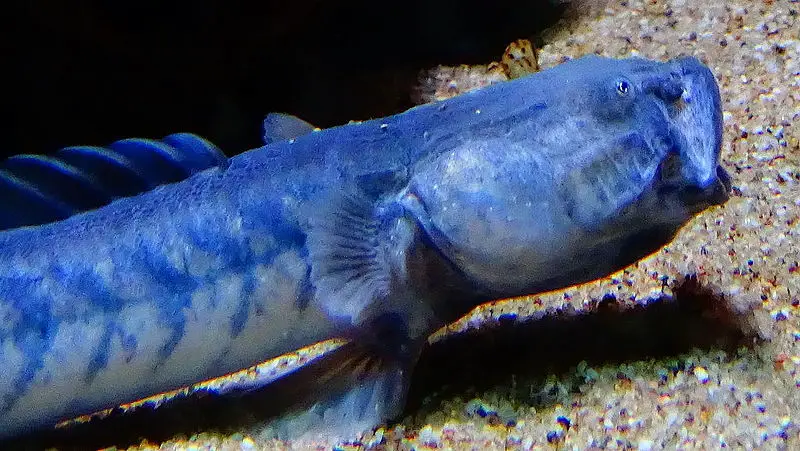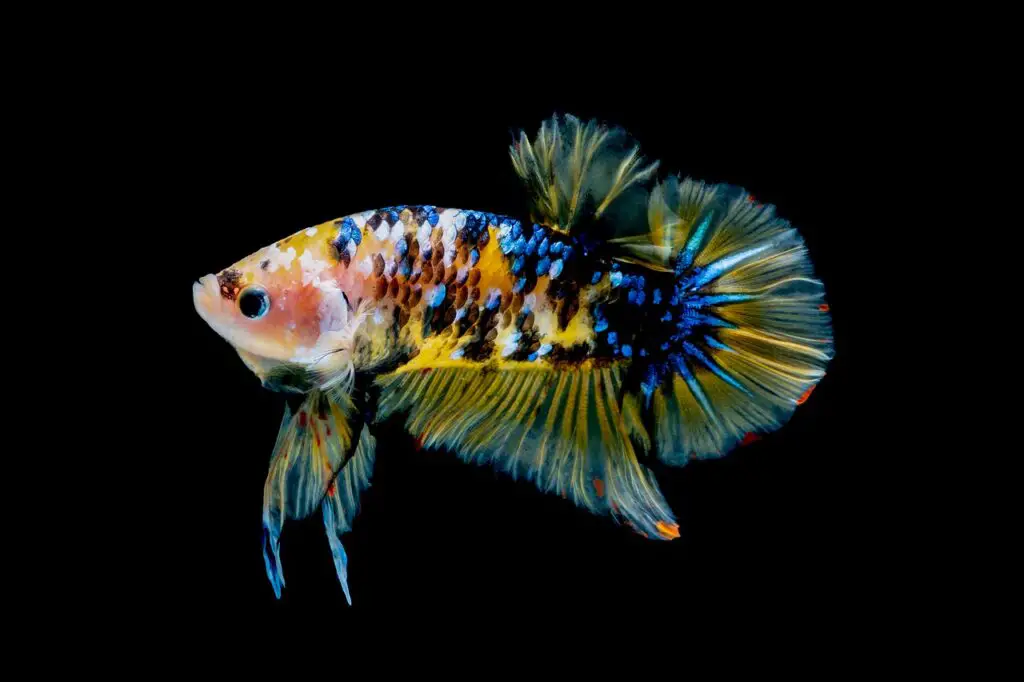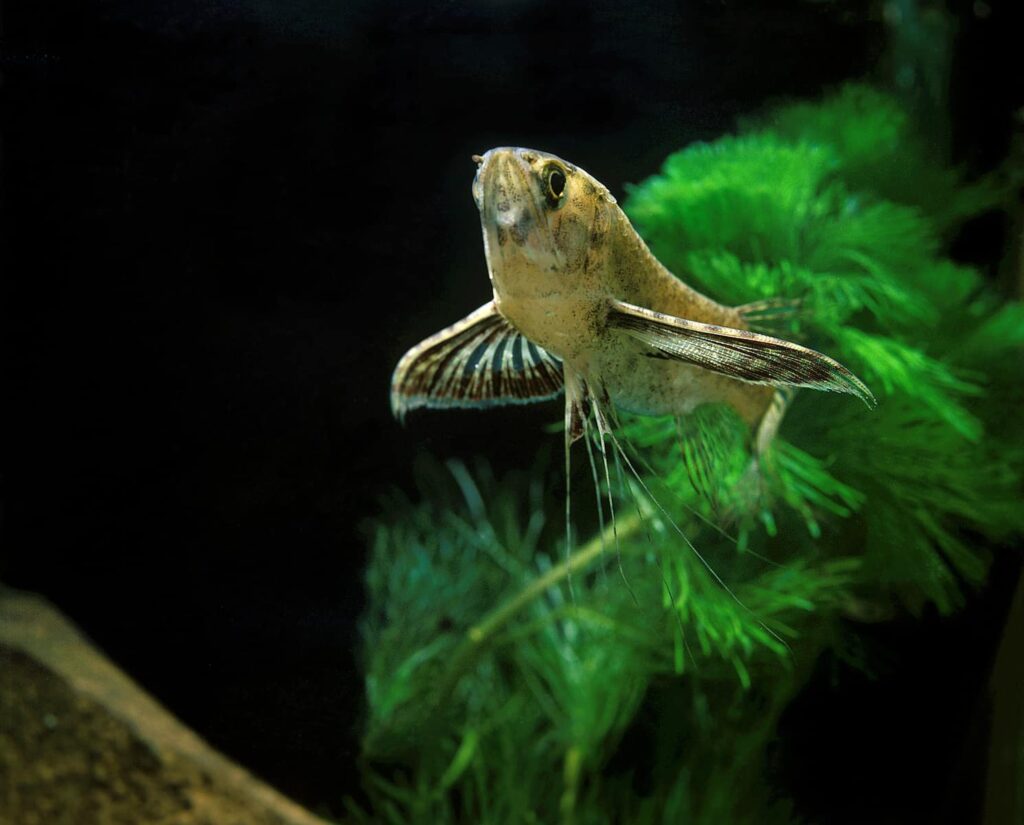Probably one of the more challenging fish to raise in an aquarium, the Dragon Goby is uniquely long and has a very interesting aesthetic, in terms of colors and shape. They’re also very skittish and are primarily found in brackish water.
Because they are skittish fish, Dragon Goby will bury themselves in the silt or even the heavier layers of sand beneath them. They aren’t as successful at this type of behavior as flounders, but they are capable of partly or wholly concealing themselves below the substrate.
Burying themselves isn’t the only way for the Dragon Goby to hide, either. If you have a lot of decorative or structural hiding places in your aquarium, you’ll often find your Dragon Goby there, whether it’s a cave, shipwreck, tunnel, castle, or house.
Their skittish behavior requires a degree of finesse when it comes to your design features inside your aquarium. If you leave them no choice but to stay out in the open, you will find yourself burdened with an unhappy Dragon Goby.
Is a Dragon Goby Reef Safe?
Most Dragon Goby are considered to be reef safe, however, the way that they consume their food has the potential for a slight degree of harm towards reef material that is very close to the bottom of your tank.
What a Dragon Goby does is suck up a mouthful of sand, consuming the tiny microorganisms before ejecting the sand out through their gills. The problem is not that they do this, but where they do it.
Once a Dragon Goby sucks in all of that sand, it may blow it out so that it sprinkles down onto the reef, which may or may not cause damage over time. Fortunately, that’s just about the worst of it and, for the most part, your Dragon Goby and your reef are safe for each other.
Is the Dragon Goby Brackish?
The Dragon Goby’s native habitat is brackish water, such as you would find in bays, ocean-fed streams, channels, and inlets. Therein lies the problem for Dragon Goby fish. Since they must live in an environment that is roughly 25% of the salinity of ocean water, that limits the other species that can live with it.
There aren’t very many fish species, that also happen to make good aquarium compatriots, that can go in your aquarium with a Dragon Goby. Also, the Dragon Goby really requires a great deal of space to be a happy and curious fish.
Although they are skittish, even a Dragon Goby can get lonely from time to time, and unless you want an aquarium entirely populated with Dragon Goby, you’ll have to get creative with fellow aquarium mates.
Monos, Scats, and Chromides will make good tank mates, however, like the Dragon Goby, these fish need a large environment. They also become quite large themselves. The Dragon Goby can get quite large on its own, and will generally grow to 15” in an aquarium.
Monos can grow to 10”, while Scats and Chromides can reach 12” apiece. So, if you’re considering a Dragon Goby, consider the tank size requirements as well as limitations on the kinds of fish that will thrive in a brackish water aquarium.
Is the Dragon Goby Aggressive?
For some odd reason, the Dragon Goby is often marketed as a highly aggressive fish. It’s a bizarre and absolutely incorrect assertion. Dragon Goby is not only relatively docile, but they are also very skittish and almost completely blind.
They are most happy with a sandy substrate in your aquarium because it allows them to bury themselves and hide. That’s not exactly the sign of a highly aggressive species. If you have a cave in your aquarium, your Dragon Goby will hide in it.
If you have plants, it will endeavor to remain behind them, coming out to get a bite to eat from the microorganisms that live in the sand. Dragon Goby will hide in just about any structure that you place inside your aquarium, and they’re certainly not going to speed out of the shadows to attack an equal or larger fish.
It’s unknown why it is marketed as an aggressive fish, so the only possible conclusion that anyone can reach is that the fish retailers who market Dragon Goby as such, have no idea what they’re talking about.
They may know a lot about Betta fish or the qualities of a starfish, but generally have no idea about the temperament of a Dragon Goby.
Do Dragon Gobies Need Sand?
Since this particular species appreciates a good burying, you would think that they would require sand as an essential component in their aquarium. And, you would be correct. Though they could probably get along without it, so long as they have a good place to hide, it wouldn’t make for a happy fish.
In fact, if you purchase a Dragon Goby, you will want to have an ample and deep supply of sand at the bottom of the aquarium. Dragon Goby tend to hover just above the sand and will live most of their lives in just that manner, slowly moving across the sandy bottom, occasionally taking a gigantic mouthful.
Do Dragon Gobies Clean the Sand?
A Dragon Goby is your best friend when it comes to keeping your sand clean in your aquarium. That’s because they feed on the organisms inside the sand, filtering the sand back out through their gills.
The organisms that live and grow in the sand can quickly become problematic if you don’t have an established cleaning routine where you filter or clean out your sand. The Dragon Goby will happily swim along the bottom, performing that function for you at a fairly quick rate.
Final Thoughts
Dragon Goby love to bury themselves and will frequently do so, even if they aren’t quite as efficient at it as other fish. It’s fun to watch, however, and owning a Dragon Goby can be a lot of fun. They are a little more on the demanding side, so it’s important to do your homework before you dive into that purchase.



